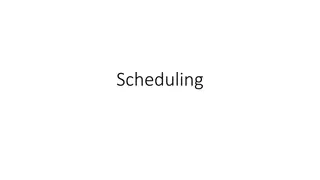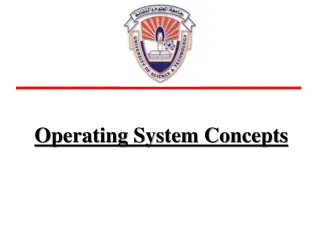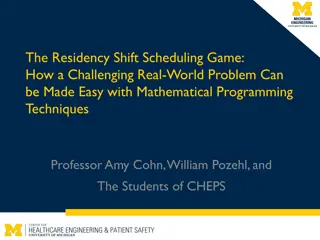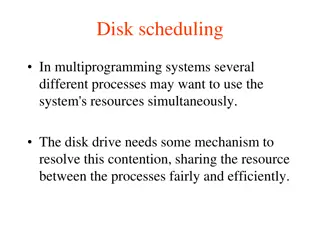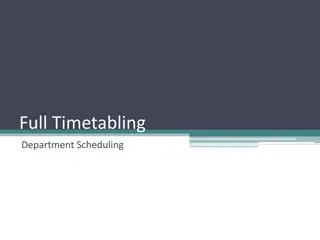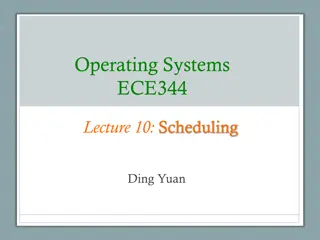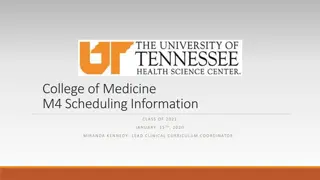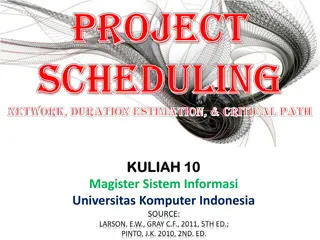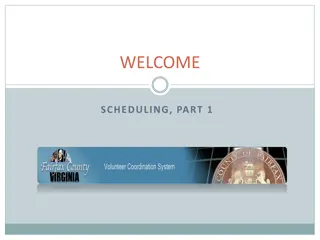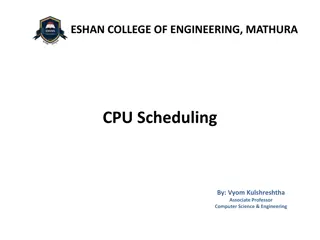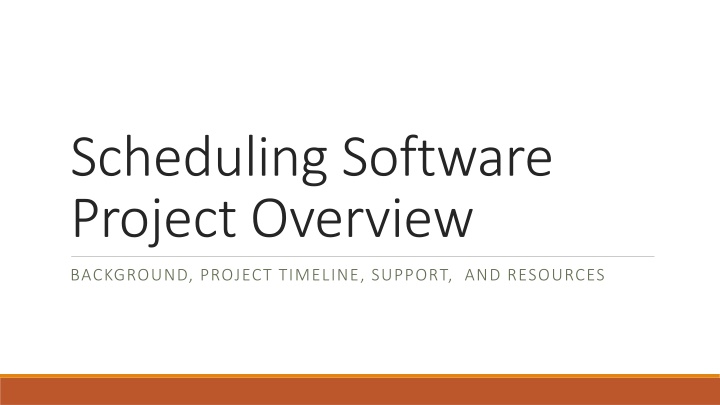
Enhancing University Scheduling Efficiency and Student Experience
Explore a detailed overview of a scheduling software project to improve student experiences, support faculty needs, and optimize university resources. Discover the driving factors, simultaneous changes, project timeline milestones, and the roles of various groups involved in the implementation process.
Download Presentation

Please find below an Image/Link to download the presentation.
The content on the website is provided AS IS for your information and personal use only. It may not be sold, licensed, or shared on other websites without obtaining consent from the author. If you encounter any issues during the download, it is possible that the publisher has removed the file from their server.
You are allowed to download the files provided on this website for personal or commercial use, subject to the condition that they are used lawfully. All files are the property of their respective owners.
The content on the website is provided AS IS for your information and personal use only. It may not be sold, licensed, or shared on other websites without obtaining consent from the author.
E N D
Presentation Transcript
Scheduling Software Project Overview BACKGROUND, PROJECT TIMELINE, SUPPORT, AND RESOURCES
Whats Driving This? We have an opportunity to improve the student experience through course scheduling improvements, to support the faculty by assigning spaces to better support the learning needs, and to use University resources more efficiently. Implementation of 25 Live enables: Transition to room assignment process based on pedagogical space requirements All class room assignments, including labs, to appear on student schedules Replacement of shadow scheduling systems by giving proprietary space owners access to 25 Live VERSION 3: 3/29/16
Simultaneous Changes Two parallel projects seek to address these goals, and raise the floor on scheduling. In addition to implementing 25 Live, new scheduling policies have been approved through University Council, and ratified by the President. 25 Live will support and enable implementation of the new policies. Scheduling Policies: Pass time increased from 10 to 15 minutes resolves issues of class disruption Standardization of the academic schedule between all programs will enable students to schedule the classes they need, and to take classes outside their program Distribution of classes throughout the day and week reduces the reliance on sub-standard space VERSION 3: 3/29/16
Project Timeline Key Milestones Key events, deliverables, and communications August November 2014 Project Kickoff. Steering Committee launched. Business requirements gathered. November 2014 RFP released. Working group meetings commenced. January July 2015 Vendor selection process and contracting August 2015 January 2016 Collection of CRC Space Data. Security role build-out. February 2016 Workflow formalized. Continued collection of space data. Security roles submitted. 25 Live environment completed. Second vendor on-site. All-scheduler meeting. Publication of project website. Training materials built. User testing. Faculty focus groups on space-needs worksheet. Scheduling Policies approved by University Council. March 2016 April 2016 Continued user testing. Training of Super Users. Class space-needs gathered by schedulers. Email to CRC Faculty. May 2016 Training available to all schedulers. June August 2016 Spring 2017 schedule building. Department and College schedulers supported by OUR scheduling team. Access to scheduling functions in UIS and 25 Live closed to academic schedulers. Spring 2017 schedule produced by OUR scheduling team. Broadcast to CRC. September 2016 October 2016 Deadline for creation of academic schedule, in advance of Registration for Spring 2017. Spring 2017 semester begins students and faculty first experience room assignments made through 25 Live and updated process. January 2017 VERSION 3: 3/29/16
Classroom Scheduling Working Group The Working Group is comprised of members from each School and College, representing both the functional knowledge of academic scheduling, and College-specific cultural contexts. It involves active participation during and outside of meetings. Ambassadors: primary point of contact on behalf of a school or college for classroom scheduling project implementation, roll-out, and ongoing support. Super-users: hands-on administrative scheduling contact, willing to be in a leadership role to get early training, and to support others in learning and using the system, procedures and practices. Meeting regularly through 2017, focusing on: Information about project progress, system functionality, and workflows Insights and feedback from academic units, and help prepare for implementation In-College communication strategies, and provide the tools & materials to provide support to academic units VERSION 3: 3/29/16
Ambassador Super User Act as a resource for academic schedulers, faculty, students, administrators Participate in user-testing Become well-versed in use of 25 Live Participate in training efforts Act as a resource for department schedulers and other system users, as well as those using the schedules including faculty, students, and administrators Provide ongoing feedback to OUR about 25 Live and scheduling process Project champion within the School or College Point-person between OUR and department schedulers Assist in communication and provide feedback to OUR Accountable for providing changes to space data to OUR Coordination of department schedulers in completing training, space needs collection, supporting security roles, and schedule-building VERSION 3: 3/29/16
School and College Representativesas of 3/29/2016 Ambassador Super User College CAS Daryl Healea Chris DeVits, Susan Jackson, Peter Law, Mark Lewis, Joanne Palfai, Stacy Straaberg Finfrock, Claire Wassinger CFA Mary Ducharme*, Alyssa Baker Mary Ducharme, Alyssa Baker CGS Stacy Godnick*, Matt Bae Matt Bae, Stacy Godnick COM Abby Clement Abby Clement ENG Stefan Scott, Ryan Schoeplein* Stefan Scott, Ryan Schoeplein* GRS Daryl Healea Laura Wipf KHC Richard Tonetti Richard Tonetti LAW Aida Ten Aida Ten, Kristin Lundberg MET Tessa Haynes Tessa Haynes, Benjamin Koha, Esther Martin-Ullrich Questrom Norm Blanchard Becky DiMattia, Allison Bello SAR Melanie Matthies*, Sharon Sankey Sharon Sankey, Melanie Matthies, Katelyn Flaherty SED Caysie Carter*, Keith Gozzolo Caysie Carter, Keith Gozzolo SHA Abby Raspallo*, Caitrin Thornhill Caitrin Thornhill, Abby Raspallo SSW Jen Warner Jen Warner STH Gina Carloni Gina Carloni, Blake Fox SPH Alan Hatton Amelia Williams Military Education Phyllis Norwood Phyllis Norwood CELOP Melanie Greitzer Melanie Greitzer * Indicates Primary VERSION 3: 3/29/16
Online Resources for Classroom Scheduling System Implementation Resource Working Group SharePoint Office of the University Registrar Web Page Link Blackboard Primary Audience Scheduling Ambassadors, Super Users, Project Team Schedulers and others involved in scheduling lifecycle; Open access to BU Community Schedulers Resource Focus New System & Implementing New policies System Implementation, Training and Communication Resources Training Purpose -Working group meeting notes & PPTs -Evolving & final FAQs -Training Plans and resources -Testing Information -Evolving documentation -Communication Templates -Ambassador Materials and resources -Training Calendar & Materials -FAQs- Approved -Key Communications -Reference Materials -Project Update -Policy Resources & Guidelines (separate sub- tab) -Tests for Training Modules -Self paced learning Availability In use www.bu.edu/reg/faculty-staff/scheduling/ Additional tabs under construction Spring Managed by OUR OUR OUR 2-18-2016 V1.2 For Inquiries & Issues: 25Live email box CR25Live@bu.edu VERSION 3: 3/29/16
Space Needs Collection Process - Overview Implementation of 25 Live enables an elevation in the way classrooms are scheduled. The current process involves a specific room request being made for each class. If the requested room is unavailable, another space will be assigned, based purely on size. 25 Live allows classes to be scheduled based on features of a space that an instructor deems necessary to meet their teaching aims. These features, or attributes, may include furniture, technology, lighting, or a specific region of campus. The process for collecting this information involves completion of a form by each instructor. Forms will be provided by academic schedulers, and returned to them. Academic schedulers will play an important role in providing information and support to instructors, and in following-up with instructors about questionable feature requirements (for example, if an instructor requested a large auditorium for a discussion section, their academic scheduler would follow-up). Academic schedulers will then input feature requirements at a section level into UIS. That data will be exported into 25 Live, where it will inform the scheduling process. VERSION 3: 3/29/16
Space Needs Collection Process - Messaging Feature Requirement is binary: The system interprets each feature requirement in a binary fashion. Each feature is either required, or not. There is no capacity to acknowledge rankings, or items that are preferred but not required. Feature Requirements limit available rooms: Each requirement narrows the pool of available rooms, and in some cases eliminates all possible room assignments. Therefore only features which are truly required should be listed. All classrooms have a standard, minimum set of features: All OUR classrooms contain, at minimum: a projector, access to the internet, connections to use a laptop to share content, and a chalkboard or whiteboard. Those features do not need to be requested they are guaranteed. High tech does not always equate to nice, or new: Some newly renovated rooms contain nothing beyond the standard set of features. Some older rooms contain a high level of technology. Requesting unnecessary features does not guarantee a new room. Defined window for input: Classroom Needs forms must be completed by 5/15/16 for Spring 2017 scheduling. Instructors who do not complete a form in that timeframe will be assigned a classroom based on enrollment limit, and departmental building preferences. Preferred rooms and buildings are set at a department level: Each department is able to set building preferences, in three tiers. This will inform the scheduling process. Back-to-back classes: 25 Live is able to identify instructors teaching back-to-back classes, and assigns those classes to the same room whenever possible and appropriate. VERSION 3: 3/29/16
Space Needs Collection Process Materials For Academic Schedulers Link to online form (provided by OUR) Training (trainings offered from 3/14/16 to 3/29/16) Mapping Document (maps specific feature requirements to form output) List of all classes, for use in tracking form completion Overview Document Supporting Instructions Glossary For Instructors Link to online form (provided by academic scheduler) Overview Document Supporting Instructions Glossary VERSION 3: 3/29/16
Space Needs Collection Timeline & Trainings Space Needs Collection Trainings: Space Needs Collection Timeline: 3/14 3:30-5 in CGS 527 February 24 March 9: faculty focus groups 3/16 2-3:30 in CGS 527 March 10: All Scheduler meeting; distribution of attribute collection form and supporting materials to academic schedulers 3/25 2-3:30 in CAS 326 3/28 12:30-2 in CAS 326 March 11 - 30: training of academic schedulers on attribute collection 3/29 9:30-11 in PHO 210 April 1 - May 31: Classroom Needs collection Please note that every academic scheduler will be required to complete this training. If you are unable to attend any of these trainings, please contact the Schedule s Department asap. VERSION 3: 3/29/16






